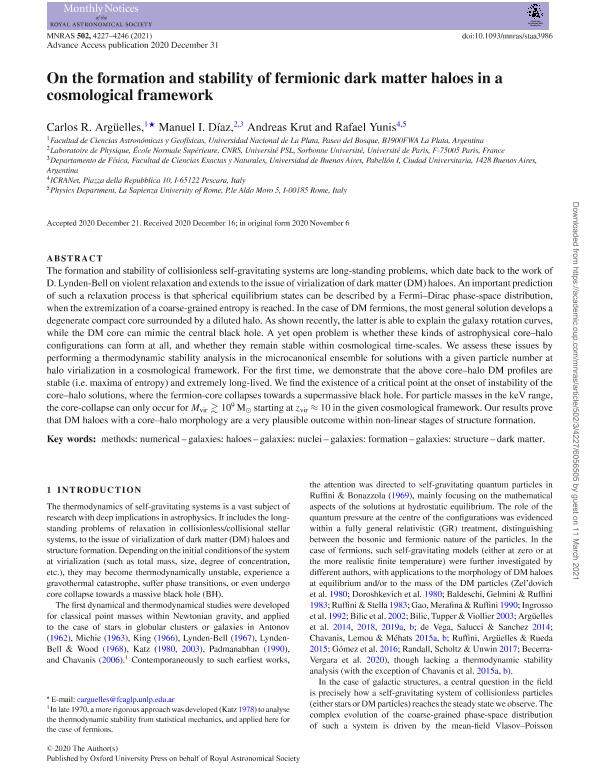Mostrar el registro sencillo del ítem
dc.contributor.author
Argüelles, Carlos Raúl

dc.contributor.author
Díaz, Manuel Ignacio

dc.contributor.author
Krut, Andreas
dc.contributor.author
Yunis, Rafael
dc.date.available
2022-05-07T02:43:13Z
dc.date.issued
2021-04
dc.identifier.citation
Argüelles, Carlos Raúl; Díaz, Manuel Ignacio; Krut, Andreas; Yunis, Rafael; On the formation and stability of fermionic dark matter haloes in a cosmological framework; Wiley Blackwell Publishing, Inc; Monthly Notices of the Royal Astronomical Society; 502; 3; 4-2021; 4227-4246
dc.identifier.issn
0035-8711
dc.identifier.uri
http://hdl.handle.net/11336/156870
dc.description.abstract
The formation and stability of collisionless self-gravitating systems are long-standing problems, which date back to the work of D. Lynden-Bell on violent relaxation and extends to the issue of virialization of dark matter (DM) haloes. An important prediction of such a relaxation process is that spherical equilibrium states can be described by a Fermi–Dirac phase-space distribution, when the extremization of a coarse-grained entropy is reached. In the case of DM fermions, the most general solution develops a degenerate compact core surrounded by a diluted halo. As shown recently, the latter is able to explain the galaxy rotation curves, while the DM core can mimic the central black hole. A yet open problem is whether these kinds of astrophysical core–halo configurations can form at all, and whether they remain stable within cosmological time-scales. We assess these issues by performing a thermodynamic stability analysis in the microcanonical ensemble for solutions with a given particle number at halo virialization in a cosmological framework. For the first time, we demonstrate that the above core–halo DM profiles are stable (i.e. maxima of entropy) and extremely long-lived. We find the existence of a critical point at the onset of instability of the core–halo solutions, where the fermion-core collapses towards a supermassive black hole. For particle masses in the keV range, the core-collapse can only occur for Mvir 109 M starting at zvir ≈ 10 in the given cosmological framework. Our results prove that DM haloes with a core–halo morphology are a very plausible outcome within non-linear stages of structure formation.
dc.format
application/pdf
dc.language.iso
eng
dc.publisher
Wiley Blackwell Publishing, Inc

dc.rights
info:eu-repo/semantics/openAccess
dc.rights.uri
https://creativecommons.org/licenses/by-nc-sa/2.5/ar/
dc.subject
METHODS: NUMERICAL
dc.subject
GALAXIES: HALOES
dc.subject
GALAXIES: NUCLEI
dc.subject
GALAXIES: FORMATION
dc.subject.classification
Astronomía

dc.subject.classification
Ciencias Físicas

dc.subject.classification
CIENCIAS NATURALES Y EXACTAS

dc.title
On the formation and stability of fermionic dark matter haloes in a cosmological framework
dc.type
info:eu-repo/semantics/article
dc.type
info:ar-repo/semantics/artículo
dc.type
info:eu-repo/semantics/publishedVersion
dc.date.updated
2022-04-26T20:19:56Z
dc.journal.volume
502
dc.journal.number
3
dc.journal.pagination
4227-4246
dc.journal.pais
Reino Unido

dc.journal.ciudad
Londres
dc.description.fil
Fil: Argüelles, Carlos Raúl. Universidad Nacional de La Plata. Facultad de Ciencias Astronómicas y Geofísicas; Argentina. Consejo Nacional de Investigaciones Científicas y Técnicas. Centro Científico Tecnológico Conicet - La Plata; Argentina
dc.description.fil
Fil: Díaz, Manuel Ignacio. Universidad de Buenos Aires. Facultad de Ciencias Exactas y Naturales. Departamento de Física; Argentina
dc.description.fil
Fil: Krut, Andreas. Università di Roma; Italia
dc.description.fil
Fil: Yunis, Rafael. Università di Roma; Italia
dc.journal.title
Monthly Notices of the Royal Astronomical Society

dc.relation.alternativeid
info:eu-repo/semantics/altIdentifier/doi/http://dx.doi.org/10.1093/mnras/staa3986
dc.relation.alternativeid
info:eu-repo/semantics/altIdentifier/url/https://academic.oup.com/mnras/article/502/3/4227/6056505
Archivos asociados
